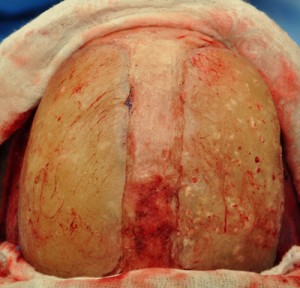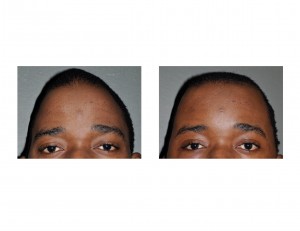Background: The appearance of the skull has a wide variety of shapes. But it most commonly has a front to back oblong shape that has curved round shape from the front that is deemed the most aesthetically pleasing. The shape from ear to ear across the top of the head should be a smooth convexity from the side muscular temporal regions transitioning across the bony top of the skull. This transition zone, known as the temporal lines, should not be too narrow to prevent loss of its convexity.
There are certain congenital skull conditions, known as craniosynotoses, that do affect the skull shape as it develops. One of these is sagittal craniosynostosis due to premature sagittal suture closure. This allows the skull to grow long in length but narrow in width. This results in a very narrow skull that often has a triangular or peaked appearance from the front view. Due to the severity of the skull deformity, most of these affected individuals undergo early cranial vault reconstructive procedures to allow the rapidly expanding brain to help achieve a more normal skull shape.
But sagittal skull deformities do not always come in full expression and there are lesser degrees of their manifestations. Some would call these microform expressions of sagittal craniosynotosis. They can be very minor or more moderate in appearance. But they all appear with a a higher and and more narrow skull shape that creates a more triangular rather than a convex shape from the front view.
Case Study: This 26 year-old male had long been bothered by the shape of his skull. He had a very peaked skull shape that he felt was too high and too narrow. He did not like its very triangular shape which he likened to that of a house roof. He wanted a better skull shape so he could feel more normal and go one with the rest of his life without being embarrassed about his unusual looking head.



Case Highlights:
1) The severely triangular-shaped head is usually the result of some degree of congenital sagittal craniosynostosis with a longer front to back length and a narrow skull width.
2) Skull reshaping of the triangular or peak-shaped deformity can be done by sagittal bone reduction, parasagittal augmentation or a combination of both.
3) A coronal incision is needed for wide open exposure to perform this form of skull reshaping.
Dr. Barry Eppley
Indianapolis, Indiana


